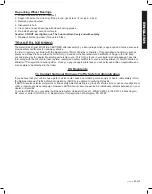
v.171214
En.m3
ENGLISH
LIgHtINg & WIRINg MAINteNANCe
WIRINg LegeND
Symbol
Color
Description
Operation
G
Green Wire
Passenger Side (Right)
Right Signal
Brake
B
Brown Wire
Running Lights
Tail light marker
Yellow Front Side Markers
Y
Yellow Wire
Driver Side (Left)
Left Signal
Brake
W
White Wire
Ground
Trailer Ground
y
NOte:
Brake light goes out on the side that is signaling.
z
Lower
filament (Brighter light) = Brake & Signal
z
Higher Filament (Dimmer Light) = Running Lights
to test vehicle wiring;
You will need a 12v light tester. Attach the wire clamp of the tester to the ground wire on the vehicle plug.
Then touch the tester pin into one of the vehicle plug contacts. Turn on the corresponding vehicle operation i.e. Running
lights. This will illuminate the tester light if the vehicle wiring is correct. Follow this same procedure for the signal and brake
lights.
to test the trailer wiring;
Once you have confirmed that the vehicle trailer plug is operating properly, connect the trailer plug to your vehicle.
Proceed to test each of the lights and power leads using your 12v light tester. Follow the wiring legend and diagram to test
each corresponding wire for power when trailer light is not operating.
Always be sure to check your brake, running and signal lights before each use. Make sure that all of your connections are
solid and that all wiring is in good condition.
Note: Bare, stripped or pinched wire will cause a short in the trailer, which will cause the vehicle fuse to blow. A
solid ground is required for your lights to work properly. All contacts must be to bare metal. Light covers should
be well maintained and kept clean. Be sure that your lights are always visible, not obstructed by your load.
LOADINg YOUR tRAILeR
A/B.
Distribute the weight evenly.
C.
Center the load over the axle, keeping about 10% of the weight on the tongue. (If vehicle wheels are not on a
crossbeam you will need to add wood to the floor to support each axle).
D.
Center the load from side to side.
e.
Always secure your cargo into the trailer properly and in compliance to local laws.
CAUtION
Do not build your trailer load higher than 3’. Higher loading will affect trailer handling due to increased wind resistance.
This may cause violent movements, accidents and serious injury.
tRAILeR CApACItY:
z
Never
overload your trailer. Each trailer has a maximum payload that should not be exceeded. Overloading your trailer
could cause serious damage to your trailer as well as the towing vehicle. Please refer to your trailer serial / certification
label located on the frame of the trailer for capacity details.
z
The Gross Vehicle Weight Rating (G.V.W.R.) is:
The Weight of the T The Maximum payload the trailer can carry. The trailer weight and the payload must not
exceed this (G.V.W.R.) weight rating.
z
Be sure that any load carried in your trailer does not extend beyond the frame of your trailer. Never place loads on one
side only.
tongue Weight
z
The tongue weight is 10% of the load (this does not include the weight of the trailer).
z
The load is divided so that 90% of the load is over the axle and 10% is over the tongue.
















































